Abstract
Somatostatin, a peptide present in hypothalamus, gastric mucosa, and pancreas suppresses several gastrointestinal functions. Its short half life has prevented clinical use. We have therefore evaluated the effect of subcutaneous administration of a new synthetic somatostatin analogue, in comparison with a placebo, on pentagastrin stimulated acid secretion in six healthy volunteers. On different days, acid secretion was measured continuously, after a basal 30 minutes, for six hours during 3 micrograms/kg/h of intravenous pentagastrin. Acid secretion was measured with a marker technique (0.1% phenol red) to correct for duodenal volume loss. Blood was drawn in regular intervals to measure plasma somatostatin concentrations by radio immunoassay. One hour after starting the pentagastrin infusion, a single subcutaneous injection of either 100 micrograms somatostatin analogue, or placebo (isotonic saline) was given. In a follow up study, somatostatin was given subcutaneously in a dose of 200 micrograms. No difference in efficacy was observed between the two doses. A single subcutaneous injection of the somatostatin analogue significantly suppressed acid secretion for five hours (p less than 0.01). Maximal inhibition was approximately 75%. Mean elimination half life of the analogue was approximately 80 minutes. We suggest that the new somatostatin analogue might be useful for clinical use.
Full text
PDF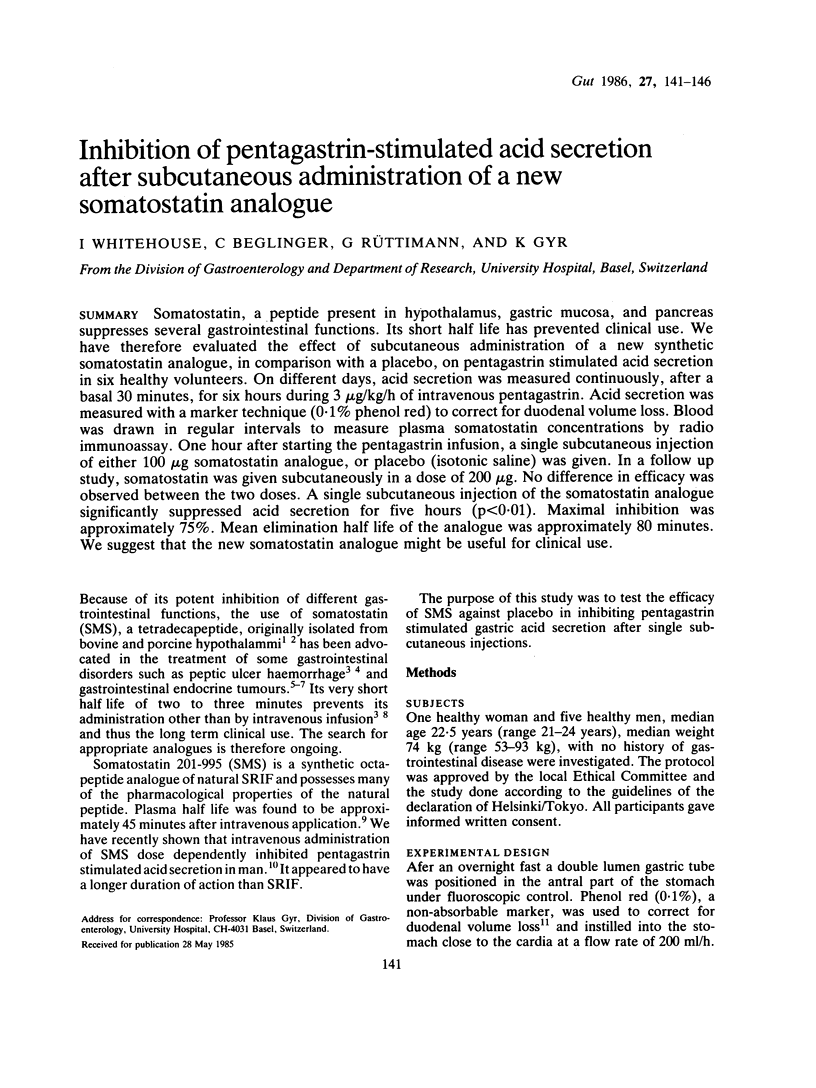
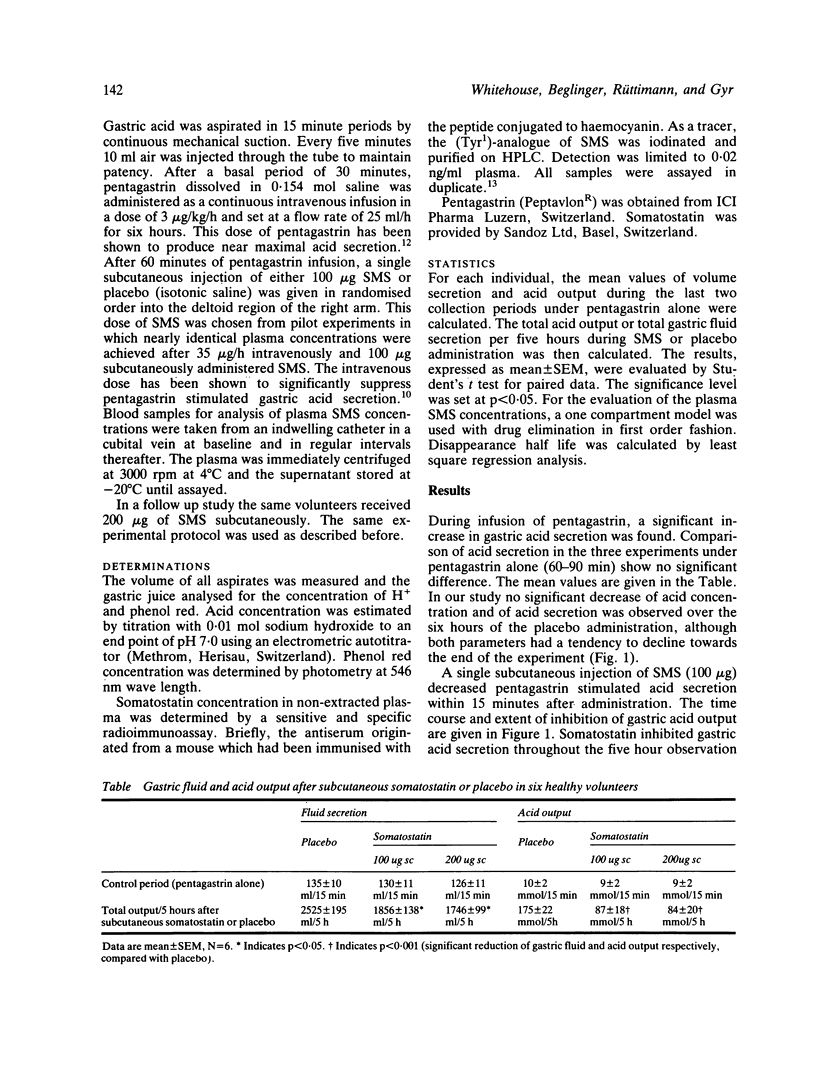
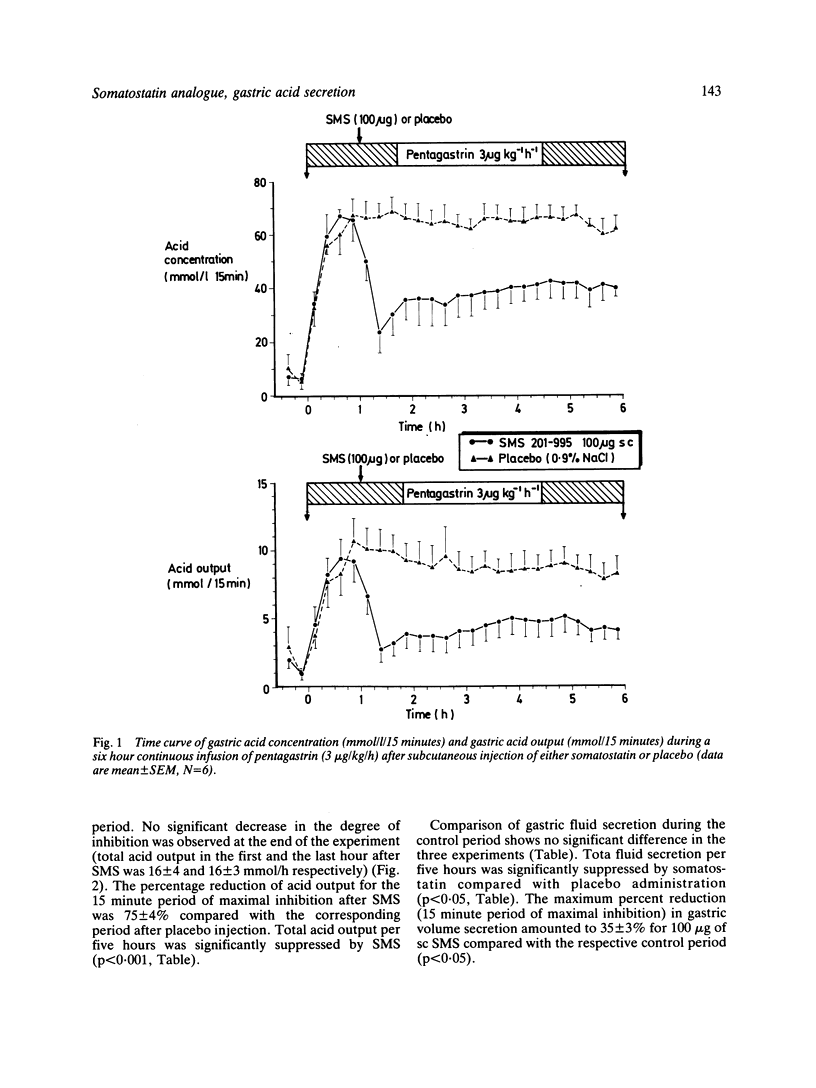
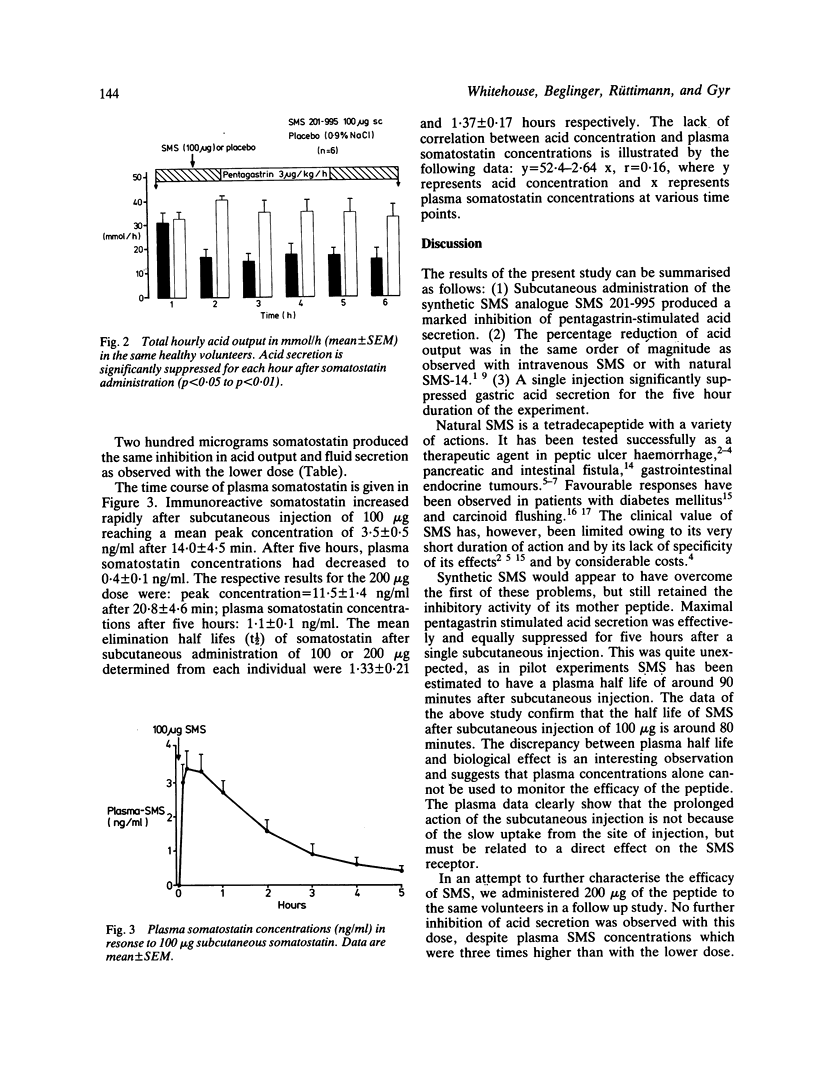
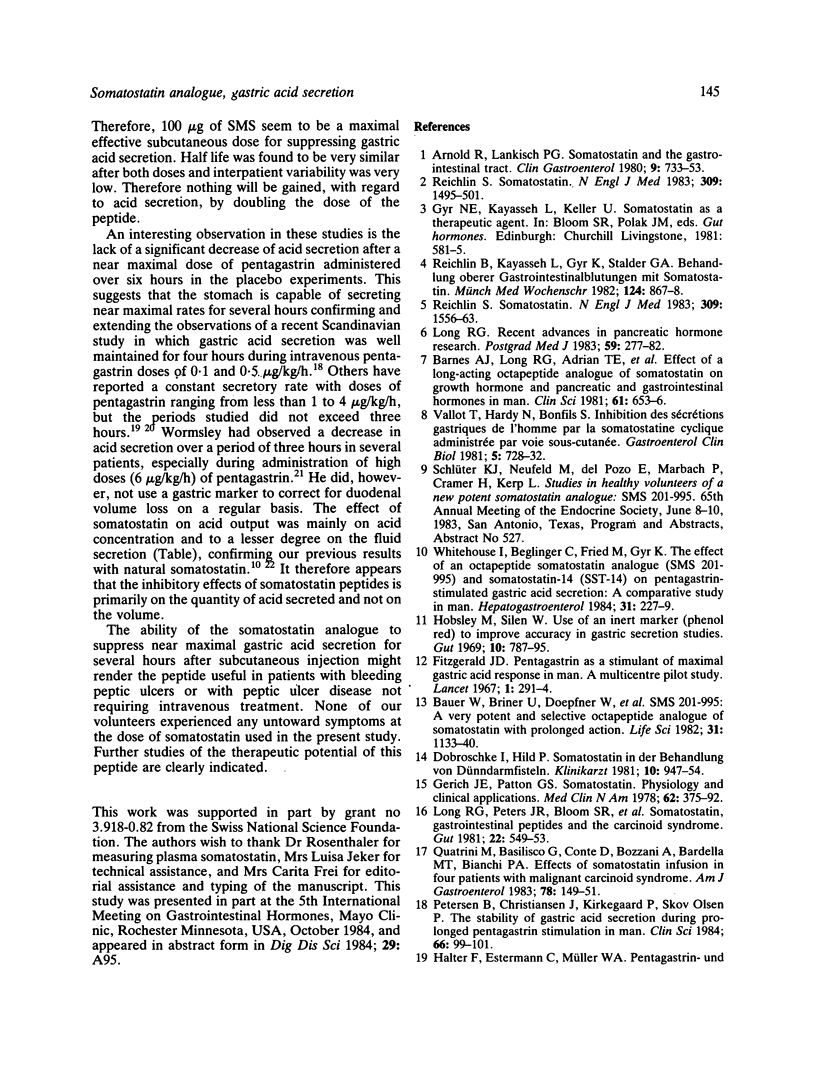
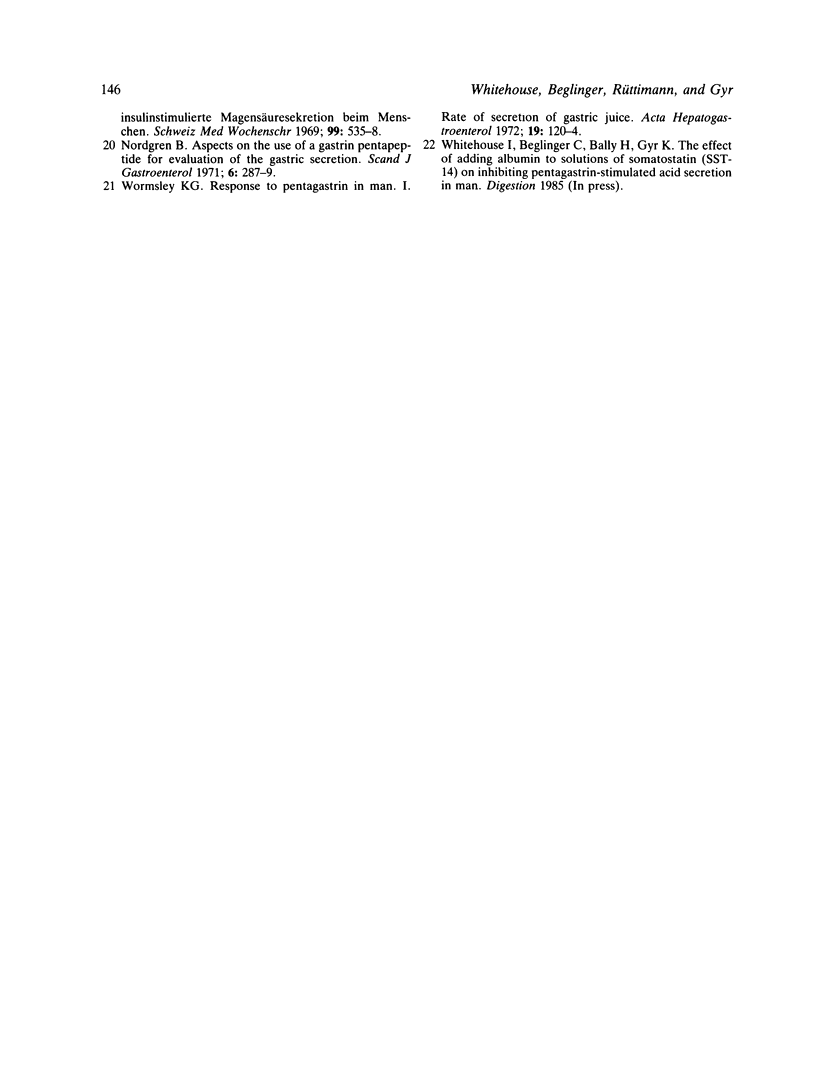
Selected References
These references are in PubMed. This may not be the complete list of references from this article.
- Arnold R., Lankisch P. G. Somatostatin and the gastrointestinal tract. Clin Gastroenterol. 1980 Sep;9(3):733–753. [PubMed] [Google Scholar]
- Barnes A. J., Long R. G., Adrian T. E., Vale W., Brown M. R., Rivier J. E., Hanley J., Ghatei M. A., Sarson D. L., Bloom S. R. Effect of a long-acting octapeptide analogue of somatostatin on growth hormone and pancreatic and gastrointestinal hormones in man. Clin Sci (Lond) 1981 Nov;61(5):653–656. doi: 10.1042/cs0610653. [DOI] [PubMed] [Google Scholar]
- Bauer W., Briner U., Doepfner W., Haller R., Huguenin R., Marbach P., Petcher T. J., Pless SMS 201-995: a very potent and selective octapeptide analogue of somatostatin with prolonged action. Life Sci. 1982 Sep 13;31(11):1133–1140. doi: 10.1016/0024-3205(82)90087-x. [DOI] [PubMed] [Google Scholar]
- Gerich J. E., Patton G. S. Somatostatin. Physiology and clinical applications. Med Clin North Am. 1978 Mar;62(2):375–392. doi: 10.1016/s0025-7125(16)31813-2. [DOI] [PubMed] [Google Scholar]
- Halter F., Estermann C., Müller W. A. Pentagastrin- und insulinstimulierte Magensäuresekretion beim Menschen. Schweiz Med Wochenschr. 1969 Apr 12;99(15):535–538. [PubMed] [Google Scholar]
- Hobsley M., Silen W. Use of an inert marker (phenol red) to improve accuracy in gastric secretion studies. Gut. 1969 Oct;10(10):787–795. doi: 10.1136/gut.10.10.787. [DOI] [PMC free article] [PubMed] [Google Scholar]
- Long R. G., Peters J. R., Bloom S. R., Brown M. R., Vale W., Rivier J. E., Grahame-Smith D. G. Somatostatin, gastrointestinal peptides, and the carcinoid syndrome. Gut. 1981 Jul;22(7):549–553. doi: 10.1136/gut.22.7.549. [DOI] [PMC free article] [PubMed] [Google Scholar]
- Long R. G. Recent advances in pancreatic hormone research. Postgrad Med J. 1983 May;59(691):277–282. doi: 10.1136/pgmj.59.691.277. [DOI] [PMC free article] [PubMed] [Google Scholar]
- Nordgren B. Aspects on the use of a gastrin pentapeptide for evaluation of the gastric secretion. Scand J Gastroenterol. 1971;6(4):287–289. doi: 10.3109/00365527109181121. [DOI] [PubMed] [Google Scholar]
- Petersen B., Christiansen J., Kirkegaard P., Olsen P. S. The stability of gastric acid secretion during prolonged pentagastrin stimulation in man. Clin Sci (Lond) 1984 Jan;66(1):99–101. doi: 10.1042/cs0660099. [DOI] [PubMed] [Google Scholar]
- Quatrini M., Basilisco G., Conte D., Bozzani A., Bardella M. T., Bianchi P. A. Effects of somatostatin infusion in four patients with malignant carcinoid syndrome. Am J Gastroenterol. 1983 Mar;78(3):149–151. [PubMed] [Google Scholar]
- Reichlin B., Kayasseh L., Gyr K., Stalder G. A. Behandlung oberer Gastrointestinalblutungen mit Somatostatin. MMW Munch Med Wochenschr. 1982 Oct 8;124(40):867–868. [PubMed] [Google Scholar]
- Reichlin S. Somatostatin (second of two parts). N Engl J Med. 1983 Dec 22;309(25):1556–1563. doi: 10.1056/NEJM198312223092506. [DOI] [PubMed] [Google Scholar]
- Vallot T., Hardy N., Bonfils S. Inhibition des sécrétions gastriques de l'homme par la somatostatine cyclique administrée par voie sous-cutanée. Gastroenterol Clin Biol. 1981;5(8-9):728–732. [PubMed] [Google Scholar]
- Whitehouse I., Beglinger C., Fried M., Gyr K. The effect of an octapeptide somatostatin analogue (SMS 201-995) and somatostatin-14 (SST-14) on pentagastrin-stimulated gastric acid secretion: a comparative study in man. Hepatogastroenterology. 1984 Oct;31(5):227–229. [PubMed] [Google Scholar]


